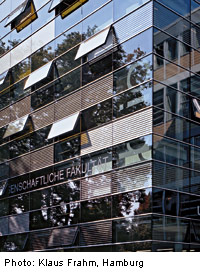Law Department Library at Hamburg University

The aim with this project was to bring together the various law libraries at the University of Hamburg and house them in a new extension to the law department building. Conceived as a compact “book tower”, the new structure is linked via a glass atrium to the existing building. Access is via the main foyer of the law department building. Projecting forward along the line of the street, the building redefines the entrance to the campus. Both buildings are connected by means of a lift and staircase in the new atrium, which acts as a climate buffer and forms the main element in the passive energy concept.
Seminar rooms and cloakrooms are on the lower ground floor, the library is on the floors above. Research systems are positioned in the open galleries overlooking the atrium, reading desks are along the facades and the book stacks themselves occupy the interior, in front of the fire wall. The extension is wrapped in a glass facade with different coloured panes which change the overall look of the building as the angle of light shifts. By day the colour effect is felt most strongly inside by the occupants of the library, by night the whole building glows with yellow-orange light. The facades of the end walls and the north wall are thermally separated framed constructions. Top-hinged sashes on the end walls assist natural ventilation. The different coloured glass panes (two shades of yellow and two of orange) reduce the effect of heat radiation in the interior and give the various study places a distinctive character, with different views of the outside.
Some of the panes are sandblasted on the exterior with broad stripes, to reduce reflections on the facade. The south-facing wall is a glass curtain wall suspended 20 cm from the insulated fire wall. This facade acts as a collector facade, pre-warming the outside air before it enters the building for ventilation purposes. Facing the adjacent villa, a listed building, stylised tree motifs were applied to the green-tinted glass by sandblasting, to create the illusion of leafy woodland. As the sun tracks across the sky, the shadows shift on the insulation behind the glass, producing an ever-changing impression.
